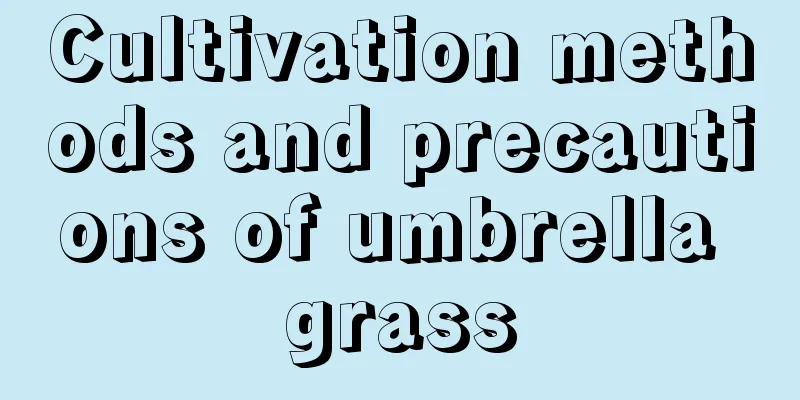Cultivation methods and precautions of umbrella grass

1. Maintenance methods1. Soil: During its growth period, umbrella grass requires the soil to be breathable and preferably have a certain degree of fertility. 2. Light: The requirements for light are not strict, as long as there is a certain amount of light every day and good ventilation. But don't expose it to excessive sunlight during the high temperatures in summer, otherwise it will be detrimental to its growth. 3. Temperature: Umbrella grass likes warm places, and the indoor temperature is most suitable in spring, summer and autumn. In winter, we are afraid of the cold, so the temperature should not drop below 5℃ and we should keep warm. 4. Water: Umbrella grass likes a humid environment and has high requirements for water. It must use mineral water or purified water. Water frequently during the growing season to keep the roots moist, and spray the leaves with water more often when the weather is dry. 2. Breeding techniques1. Sowing: Pick the mature seeds in October, air-dry them and store them. In March or April of the following year, sow the seeds in a pot with soil, cover them with soil and water them to keep the soil moist. They will germinate after 10 days and can be moved into pots when they grow to about 5 cm. 2. Division: Division propagation is suitable for repotting in March or April. Take the mother plant out of the pot, cut it into several strips and place them in the upper pot. You can divide and plant them at any time, and the survival rate will be very high. 3. Problem diagnosis and treatment1. Yellow leaves: You must water it more often in summer, otherwise yellow leaves will occur. Water it every night to prevent its leaves from turning yellow again. 2. Root rot: There should not be stagnant water in the soil. If it is soaked in water for a long time, the roots will rot, which is not conducive to its growth. IV. Other issues1. Can it be hydroponically grown? Yes, it can be hydroponically grown using lake water, river water, well water, or tap water that has been settling for 24 hours. Mineral water cannot be used for hydroponics. You can put pebbles in the bottle to stabilize the center of gravity of the flowerpot, which will look beautiful. 2. Is it toxic? It is not toxic. Umbrella grass is easy to manage in life, has certain ornamental value, and can purify the air and remove harmful gases. |
<<: Cultivation methods and precautions of group jasper
>>: Yam bean cultivation methods and precautions
Recommend
Can fallen leaves be used as fertilizer if buried directly in the soil? How to ferment leaves to make fertilizer for flowers?
When we grow flowers and plants, we often use soi...
Jasmine cultivation methods and precautions
1. Soil Jasmine cultivation requires soil with go...
How to water red maple bonsai
According to the habits of red maple Red maple is...
What is Sphagnum Moss?
Introduction to Sphagnum Moss Sphagnum moss, also...
Can lantern flower be hydroponically cultivated? Hydroponics rooting method
Can lantern flower be hydroponically cultivated? ...
What kind of water is best for watering asparagus fern?
1. Sugar water Dilute the prepared sugar water wi...
Chrysanthemum fertilization method, what fertilizer to use
1. Fertilization time Chrysanthemum has relativel...
How to grow grapefruit for high yield (how to grow big and delicious grapefruit)
As a tropical and subtropical fruit tree, pomelo ...
What is peat soil and what are its advantages and disadvantages?
1. What is soil Peat soil, also known as peated s...
How to change the soil and pot of camellia
Camellia soil and pot requirements Camellia is a ...
How to plant okra, how to plant okra seeds
1. Planting time Okra is generally planted in spr...
Use them to grow flowers. Throw a handful into the soil and 100 flower buds will bloom.
Many friends who grow flowers hope that the plant...
These 16 "well-intentioned" actions of yours are quietly harming your succulents!
Keep it indoors and keep me company every day Myt...
How to breed white jade tiger skin orchid and precautions
How to reproduce white tiger lily There are two w...
How to water daisies
Tips for watering daisies Daisy is also called am...









